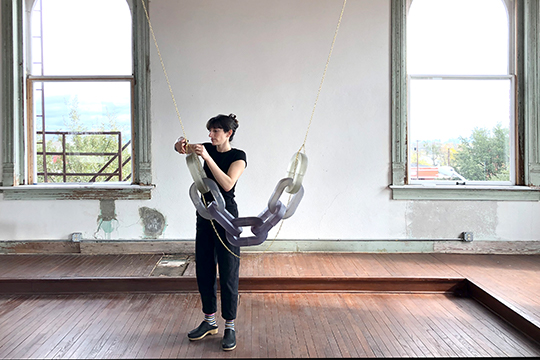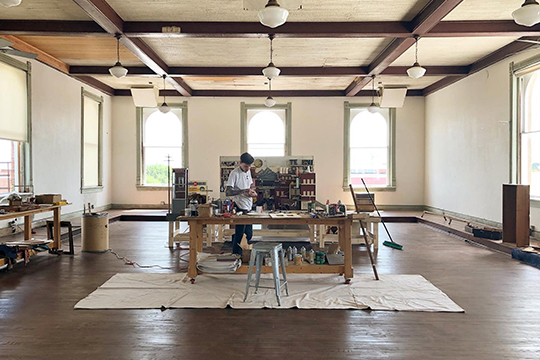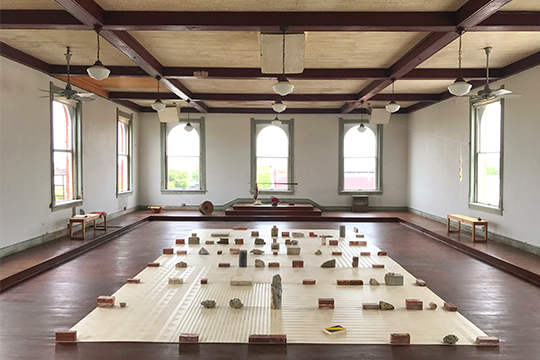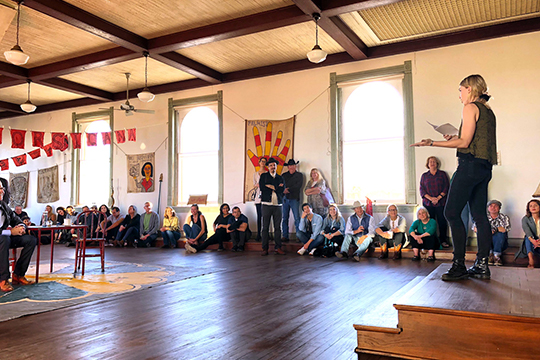The woods are a favorite destination for creative inspiration: flowing rivers, Edenic seclusion—the perfect prereqs for an artist residency. But what about a small town in a dry county with a checkered history, decades past its prime? Is that a place where the arts can—must—flourish?
In January of this year, I packed a third of my winter wardrobe, a hand-painted tea set, and as many books as I could into three suitcases bound for Corsicana, Texas. It’s a town that many have left behind, but I keep coming back to—first as a poet-in-residence and now as an official transplant to take a job as the first director of public programs for Corsicana Artist & Writer Residency.
 The word residency comes from the Latin verb residere, which means sit down, settle; remain behind, rest, linger; be left. Its etymology is especially interesting to consider in the context of Corsicana: a town of now only 26,000 people but that once rivalled the population of Dallas. Economic decline and the ongoing exodus of young people has landed many small towns like Corsicana in a decades-long crisis. Once-prosperous municipalities are starved of vital business and tax revenue and drained of the youthful energy needed to lubricate the gears of change.
The word residency comes from the Latin verb residere, which means sit down, settle; remain behind, rest, linger; be left. Its etymology is especially interesting to consider in the context of Corsicana: a town of now only 26,000 people but that once rivalled the population of Dallas. Economic decline and the ongoing exodus of young people has landed many small towns like Corsicana in a decades-long crisis. Once-prosperous municipalities are starved of vital business and tax revenue and drained of the youthful energy needed to lubricate the gears of change.
So when artist and furniture maker Kyle Hobratschk started an artist residency in the heart of downtown Corsicana nearly 10 years ago, it was an intervention. Small town populations keep dwindling, but residencies like this one attract people from all over the world, insisting that major cities aren’t the only fertile ground for creative communities.
The slower pace of life in Corsicana instructs our residency’s approach to the arts on a human scale. In the 100 West building, the founding site of the residency, there is ample room for three residents, and we prize the generosity of space that both the building and the town provide. Our two-month stays allow residents to bring forth work from patience and experimentation rather than from the knife edge of incessant production. Painter and recent resident Theodora Allen remarked that her residency was the first time since finishing graduate school that she had the luxury to make work without deadline or the pressure of gallery deliverables.
Longer stays also allow residents to form bonds beyond the walls of their studios. Photographer Noel Camardo came to the residency intending to tell the story of American life by taking photographs and talking with people in different towns across the country, but that changed during his stay. Camardo realized “I was telling the story [of America] better through Corsicana. I had the opportunity to be there for 45 days. Being in one place for an extended amount of time allowed me to have access to people I never would have had [if passing through]. Corsicana is a fairly diverse town economically and racially. I could use Corsicana to talk about issues in America that are interesting.”
Since the end of his initial residency five years ago, Camardo has spent over 210 days in Corsicana talking with local people from every neighborhood. He remarked that this project would have never been possible without the residency, the founding artists’ hospitality, and a consistent place to stay.
 Many life-long Corsicanans have become involved in the creative output of residents. A number of those folks— Joe Brooks, founder of the Warehouse Living Arts Center, former high school principal, and philanthropist, and city council woman and community advocate Ruby Williams —also serve on our board, helping maintain the close dialogue between the town and the vision of the residency within it. These relationships that connect the residency and the town are what kept me coming back year after year.
Many life-long Corsicanans have become involved in the creative output of residents. A number of those folks— Joe Brooks, founder of the Warehouse Living Arts Center, former high school principal, and philanthropist, and city council woman and community advocate Ruby Williams —also serve on our board, helping maintain the close dialogue between the town and the vision of the residency within it. These relationships that connect the residency and the town are what kept me coming back year after year.
Like a natural stream, residents flow through the doors of 100 West and deposit remnants of ideological, cultural, or artistic alluvia as they open their studios to visitors, teach workshops at the high school, and chat with local fixtures on our Rope Walker podcast series. As the residents dwell in this place of thoughtful architecture and charged histories, their work in turn picks up some of Corsicana’s unique sediment and carries it back to geographies as diverse as Miami and Korea. It’s an organic process of gestation and random encounter that leads to cross-pollination. The work is profoundly ecological.
Founded on the principles of architectural preservation, Corsicana Artist & Writer Residency is now considering what preservation looks like through this broader kind of ecological lens. My mind rings with a recent question from board member and visual artist Sally Warren, “Is it enough to present the veneer of history, or do we go deeper?”
After nearly a decade of committed work—first in painstakingly preserving the 130-year-old Neoclassical-Italianate former Odd Fellows Lodge, and then in hosting over 100 artists and writers in its light-limned studios—the residency is wading deeper into communal waters. A main component of that work involves the opening of the residency’s bookshop and public art space. The bookshop will give community members a place to probe the literature and art created in the studios even after residents leave.
 Opening a bookshop—the only one in Corsicana—both responds to a tangible community need and deepens our participation in Corsicana’s literary and economic ecosystem. COVID-19 and the atrophy of many public spaces left Corsicana without venues to gather and exchange divergent ideas. Like fetid water, communities can become stagnant when ideas and inspiration cease to flow. The bookshop is another intervention.
Opening a bookshop—the only one in Corsicana—both responds to a tangible community need and deepens our participation in Corsicana’s literary and economic ecosystem. COVID-19 and the atrophy of many public spaces left Corsicana without venues to gather and exchange divergent ideas. Like fetid water, communities can become stagnant when ideas and inspiration cease to flow. The bookshop is another intervention.
In our new public space, we are not just making resident work visible, we are making the residency permeable. People can come in and out, and the way that they relate to the space and our work will inherently impact and refine it. We have always led with relationships; our larger emphasis on public programs like film screenings, book circles, readings, and art workshops only deepens those relationships. When visitors come to Corsicana, they’ll have a chance to connect with residency staff, engage with the artists’ materials, and read the 35 titles our residents have launched into the world—many of them written just down the street at 100 West.
The expansion of our program is exciting, and yet most ecosystems are incredibly fragile. Creating a sustainable environment for literature and the arts in a small town requires both bringing in outside artists to make work and building arts capacity within our public institutions to foster emerging local talent. Our artist and writer public school visits, made possible through a local grant from the Navarro Council of the Arts, are one important way we do this. In March, writer and former resident Marian Bull walked students through several memoir writing exercises. In April, painter Kemar Wynter invited students into his studio practice, challenging them to use oil pastels to translate favorite dishes into visually abstracted memories.
 Support for art in public places means carving out channels for sustained artistic engagement within our public institutions like schools, libraries, and community centers—creating a world where ideas about the arts and interest in literature pass from one space to another and eventually permeate the whole community. In such a world, Corsicana’s most skilled emerging artists would be able to sustain lucrative careers without having to leave their hometown behind.
Support for art in public places means carving out channels for sustained artistic engagement within our public institutions like schools, libraries, and community centers—creating a world where ideas about the arts and interest in literature pass from one space to another and eventually permeate the whole community. In such a world, Corsicana’s most skilled emerging artists would be able to sustain lucrative careers without having to leave their hometown behind.
During a 2013 speech at Vanderbilt University, writer Toni Morrison encapsulated the deeply interdependent nature of art that an ecological perspective attests to: “Art reminds us that we belong here. And if we serve, we last.” Last, linger, residere. We leave something behind. Sediment in the stream. Pebbles in the creek. In any case, I hope our residency does what Morrison says: reminds people questioning whether their ideas, culture, or body belong in a place like Corsicana that they, in fact, do.
Taking up the dual responsibility and privilege of belonging to this place, former residents of 100 West are becoming permanent residents of Corsicana— painter Nancy Rebal, essayist David Searcy, and now me. We left behind our urban digs to make full-time commitments to one of America’s small towns because we know something worthwhile exists here, and we want it to last.
Alysia Nicole Harris is a poet, linguist, teaching-artist, and currently director of public programs at Corsicana Artist & Writer Residency. She received her Ph.D. in linguistics from Yale University and her MFA in poetry from NYU. Alysia has spent over a decade performing nationally and internationally, including at the UN, the US embassies in Jordan and Ukraine, and the National Theatre. Since 2016, Alysia has worked with an array of nonprofit organizations in program development and mission-based consulting. She also serves as arts and soul editor for Scalawag Magazine and theology editor at EcoTheo Review.
Photography by Kyle Hobratschk.